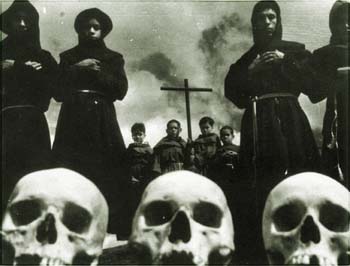Que Viva Eisenstein
Missionaries in Position: A typically dynamic composition demonstrates Eisenstein's view of the oppressive power of the Catholic Church in Mexico.
Even in fragments, the world-renowned Russian director's historical Mexican epic impresses
By Richard von Busack
THIS WEEK'S program in the Cine 16 series--titled "A Dream of Mexico"--features a rare chance to see what's left of one of cinema's most famous unfinished projects: Sergei Eisenstein's Que Viva Mexico! Bankrolled by $25,000 of the California socialist Upton Sinclair's money, the world-renowned Russian director of The Battleship Potemkin went to Mexico in the early 1930s planning to make a sort of Communist Intolerance, set against the history of Mexico in four segments: Pre-Columbian life, the coming of the conquistadors, the 1910 Revolution and a Dia de Los Muertos celebration. The money ran out, and Sinclair shut the production down. Stalin recalled Eisenstein to the Soviet Union so that the dictator could interfere with the director's future work more easily. The footage shot was returned to America, where, despite Sinclair's promises to ship it to Russia, it languished--ignored, resold and parceled out as stock footage.
In Time in the Sun, an hour-long assemblage put together in 1939, much has been done to sabotage the quality of Eisenstein's work. The sabotage was in vain; the handsome compositions and sumptuous black-and-white photography would look good even projected on a dirty bed sheet. Sometimes, Eisenstein falls for the stereotypes that haunt the minds of a tourist. The third section's tale of a peon whose intended bride is requisitioned by the lord of the manor for droit du seigneur while some Yankee financiers jeer is heavy-handed propaganda from the most talented propagandist who ever lived. Far more impressive are the sequences of the matriarchal Tehuanas, who have a wedding wearing their typical headdresses that make their faces look like flowers in bloom. And the Day of the Dead finale is terrific, with a fireworks-like montage of masks, dancing and those wonderful papier-mâché skeleton toys.
Also showing: Pedro Linares: Artesano de Carton (1975), a Spanish-language documentary on a papier-mâché monster maker; Cumpleanos de Pepita (1957), a language-instruction travelog that includes a stop at Lake Patzcuaro; and Centinelas del Silencio (1971), a helicopter tour of some spectacular Maya and Aztec ruins.
[ Metro | Metroactive Central | Archives ]
This page was designed and created by the Boulevards team.

Museum of Modern Art/Film Stills Archives
Cine 16 takes plays Thursday (Dec. 12) at 7:30pm in the basement of the Agenda Lounge, 399 S. First St., San Jose. Admission is free.
From the December 12-18, 1996 issue of Metro
Copyright © 1996 Metro Publishing, Inc.
![[Metroactive Movies]](/movies/gifs/movies468.gif)